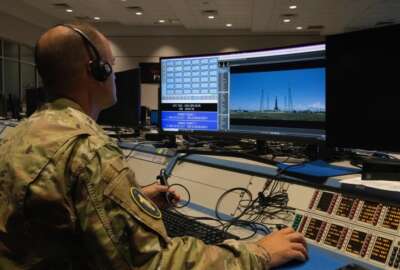Hubbard Radio Washington DC, LLC. All rights reserved. This website is not intended for users located within the European Economic Area.
The future of DoD and space technology
Preston Dunlap was the first chief technology officer (CTO) and chief architect officer of the U.S. Space Force and Air Force. He's now an independent director ...
Eric White got the chance to speak to someone who was among the first technology experts in the U.S. Space Force. Preston Dunlap was the first chief technology officer and chief architect officer of the U.S. Space Force and Air Force. He’s now an independent director on corporate boards and advisor for companies such SOSi. Here is that interview.
Interview Transcript:
Preston Dunlap I had the privilege of being part of getting two tech startups off the ground in the commercial world and working for four secretaries of defense. Most of the time spent running the Pentagon’s equivalent of an investment committee and diligence teams on how to effectively spend wisely about $700 billion a year in five years for pictures. And then most recently had the privilege of being the first chief technology officer and chief architect for the U.S. Space Force and Air Force after working national security programs for Johns Hopkins Applied Physics Lab. And now I founded Arkenstone Ventures to be able to provide consulting and strategic advice to tech companies that are growing and trying to create real change in the tech world with a lot of emphasis on space and other deep technology areas, as well as work with private equity firms to increase investments in this still underserved area, but a real area of promise.
Eric White What goes into, and forgive me for making it sound so simple, but what goes into being the CTO and chief architect officer of the Space Force and Air Force? I imagine a lot of technology needs are are pretty high up there in the realm of things. But what can you tell me about that position?
Preston Dunlap Yeah, I really credit the secretary at the time who was overseeing the department at the time was just Air Force. And you might recall that the president decided to create and stand up the Space Force at the time, a second service inside the same department. And the secretary recognized that the way the government often manages programs and development is as if there were sort of individual islands of themselves. And so although the there weren’t necessarily technologists that were running the department at the time, they recognized that there was something that didn’t feel right about simply having a thousand sort of flowers moving and blooming and instead ought to think about technology more as an integrated approach like a successful company might. So you want to not just have a bunch of widgets that you sell or produce, but you want to be able to have a coherent strategy that reinforces each other and some application of the technology development as an enterprise approach across your whole set of product lines. And so to begin to think about the military and the Defense Department intelligence community as not simply a series of individual activities, but a coherent plan to achieve perhaps some of the most strategic and critical objectives for our country and those around the world makes a lot of sense to be able to set up a teams of people, to be able to think about how to build products and capability more quickly and how to do so thinking about them as a collective whole, because we use our capabilities together. And so not just fighters or submarines, but we bring them together to deter and if necessary, take action. And so you want to be able to build that in from the beginning and to think about a coherent technology strategy. And part of that is being able to bring in things like commercial technology for many elements that are critical to the military but are not as organically grown by the military like they used to be. That’s the chief technology aspect. The chief architect side of the coin was another great idea, which is to be able to ensure that the engineering across in our department about $74 billion of research, development and procurement activities are actually done in a way that works together from the beginning and experimented and tested and evaluated and deployed together as family of systems or families of capability. So great honor to be able to do that for just over three years.
Eric White How far along from your perspective, has space technology come in the U.S. from a defense standpoint? Everybody knows about the great movements that satellites have have upgraded to themselves. But from a defense standpoint, what have you seen over the years in those positions and now in the commercial sector?
Preston Dunlap Yeah, this is sort of near and dear to my heart. Back when I was working as an executive at Johns Hopkins Applied Physics Lab, I was having some conversations with the White House senior staff at the time. This would be 2015, 2016 timeframe. And the the thesis that I was sort of making was that there is a tectonic shift that’s about to happen and maybe even is happening at the time, which was a rapid trend towards less so having government preponderance in space and more so having the preponderant player be commercial and other ecosystems up in space. And so you’re you’re right to note that change in trajectory that but that necessitated a new thinking inside the government and that new thinking caused myself and a team to then run for Vice President Biden at the time, and then a second set of activities for Vice President Pence, exercises with the cabinet and the vice president chairing those activities. And what became known as the National Space Council that President Trump and VP Pence stood up. But in the backdrop of all those more public forums, we were looking at what it looks like to have policy and programs that would need to be developed. And you saw activities come out of that like the stand up and focus of US Space Command, a military command oriented on the domain of space that started in 2018 and formalized in 2019. We have others that are geographic focused, like Pacific or Europe or and so on. But this recreated a focus specifically on space. So there was that’s the operational side of the house, the users. At the same time, there was another public debate on the Space Force establishment that also got established in December 2018, and that was to then organize, train and equip programs, people and processes to be able to then enable and support military and other capabilities in space and a large emphasis, an increasing percentage of emphasis on either adopting commercial technologies or relying on commercial companies. And so we see a more clear need to do that as aggressive actions have happened in space from others. And so we want to make sure that we have a stable and secure space economy just as we ensure that we have a stable and secure maritime domain and other locations around the world and hand in hand in glove with our partners across the globe.
Eric White A nice segue into my next question, which is is the space economy, the U.S. space economy and international space economy up to the task of providing those needs that the government has? Or are there still some gaps of where there’s whether it’s a lack of competition or lack of innovation that the defense side and the intelligence agencies have needs that are not necessarily being met?
Preston Dunlap Yeah, there’s two ways to think about that question, Eric. So one is from an investment perspective, so there’s a significant amount of money, an increasingly amount of money goes into building space capabilities across the globe, about a portion of that. So let’s see, two years ago was about $250 billion investment in space, but 90 of that across governments, about 55 billion of that 92 from the U.S. government and about half of that sort of split roughly between Space Force or Space Force and the NASA. That that that dollar amount is large by most of sort of our standards, however very small relative to significant technology domains in other areas or sectors like enterprise software and so on, if you sort of add up the aggregate. So it’s a good number, but it’s not sufficient to be able to address all the commercial the day to day needs that are needed from phones and GPS to imagery and agriculture. And so what you need to do then from a government perspective is focus those dollars on systems and capabilities that you need specifically or uniquely for defense and intelligence missions, and then leverage the vast investments out there in the private sector, building products for commercial entities that we can dual track. Some people call it dual use. I prefer the term dual track so that you’re not distracting from the commercial business case, but a dual track into the government case where we can you rely on that an increasing way. Not simply, originally the argument I think was for resilience and redundancy, to be able to have multiple pathways of information and the but now I think we’re seeing companies be sophisticated enough that they can actually sort of be hand-in-glove and be integrated into algorithms that create insights and leveraging of machine learning and AI to be able to pull not simply one type of image or one type of information together from space, but actually have a very strong fabric or a collective whole that is that sort of makes one screen, if you will, not on a commercial screen that you’re looking at in a government screen, but one that’s blending the two together. And we’re always going to see specialized capabilities or needs that the government is going to have in that, both in space, space for space as well as space to earth. I don’t think that’s going to change. Same thing with with missile systems or aircraft. There’s not a lot of commercial need for, say, a hypersonic weapon, but a lot of military needs, those kind of things. It’s a nice, clear example of something that may not be a commercialized product, or at least I hope it isn’t, but it’s something that the government would need. And there’s moral equivalence of that in space.
Eric White Yeah, the space race is back on between the U.S. and its near-peer competitors. I just want to gather your thoughts on what you think about U.S. companies being able to maybe work with other other countries who have those same needs as well. Where does their allegiance lie? And as a former CTO, what were you hearing from the Space executives when this topic came up?
Preston Dunlap Well, we’re seeing a large, I think, increasing trend for countries around the globe to be more interested in getting into space. The really the flexible point or the pivot point that happened to enable new entrants into the space is the dramatic reduction of things like launch costs. Where it was something like 25, $50,000 a kilogram back on space shuttle days all the way down to 2000 a kilogram for Falcon nine. And if Starship Bay gets off the ground, literally, that could be much, much, much reduced. And so those those create opportunities to be able to and reduce barriers for others to be able to enter. And so I think we’re looking at lots of partnership conversations across the landscape, countries thinking about whether they want to have their own sovereign capabilities versus leverage others. And I think from a United States perspective, we’re we are doing very well in the space domain. And a lot of companies want to come here and work or be part of the US ecosystem for good reason. Got a lot of great technical talents, a good focus on this and and an environment and government structure that’s very supportive of increasing commercial companies. And so I think we’re going to continue to see companies doing that, not simply for a first, it’s going to be in looking, I’ll call it space to space to Earth, but Earth observation and other more obvious categories. But as communications are built and transportations and our costs are reduced both to get to low-Earth orbit, but then eventually here we’re going to see beyond low-Earth orbit, you’ll see more and more companies and governments working together to be able to have things like taxi systems in space and potentially other interesting businesses that could be established on top of this foundation. And so all the more reason why there’s good economic reason for it, good commercial reason for it. And to be able to support that, you want to make sure that you’ve got a stable and secure environment with rules of the road to be able to operate together as an ecosystem from country to country and company to company.
Eric White Yeah, finishing up here and you provide another great segway to this question, which is which is where is this all going and where do you see this all going? Are we going to see you mentioned those taxi services, are we going to have planes that are going to be flirting with that line between low-Earth orbit and and actually being considered on earth or what what are some of the things in the pipeline that you can foresee as somebody who’s been in this industry, an area for so long?
Preston Dunlap Yeah. So there’s a lot of potential and you could do a lot of dreaming about what in space activities can look like and then space activities that support what’s what’s happening down here on Earth, the road to be able to get there if you want to build it or the bridge from today, it’s tomorrow. We started with the changing the way launch happens, both in terms of the weight and where you can go and what the costs are. I think the next thing that’s interesting is then the communications to be able to then support that. By that I mean how do you talk to people or things at great distances and to set up the communications infrastructure to be able to support movement out and beyond and pathways to do that? And once you’ve got communications set up, allows greater autonomy and systems to work together, which create an environment that allows things to be built and to work together out in space. And I think we’ve got a somewhat of a it’s not a blank canvas, but I think there’s a lot of creative opportunities here for those that are are investing or looking in the potential of once a few of these things lock into place to create that that bridge. That could be a very fascinating future in space and that there could be not simply things like civilization or people living places, which we often talk about or people think about. And there’s certainly the possibility of that. But there’s also various things in space that are useful as well, and not just for economic advantages, but to be able to help make make life better here and more productive, more useful, more stable. So I think we’re going to see a lot of creativity, opportunities for companies and governments that are trying to do that and want to rely on on countries to then make good policy and good rules to be able ensure that folks play well together and reinforce each other in a way that’s stable and fair to support that flourishing for companies and let the let those companies be creative and take bold steps with how they use their dollars time and talents to be able to to make that future actually be realized. I think spaces is something that we often take for granted. It’s in our cars and our phones, on our computers. And every every day that goes by, space is going to be a more integral element in our daily lives. Often if we do that right, we may not even notice that that trend is happening. But what that means is you’re able to have a more globally connected set of communities across the world, which creates a new opportunities to partner and understand others better and work together more collaboratively. So whether that’s for location services or agriculture, the maritime issues or just talking to each other let alone the opportunities up in space, there’s whether we see it or not, or recognize or not space is going to be a part of almost everyone’s life at some point here in the in the coming future. And I think that’s that’s a good future to go into. And we should do it wisely and thoughtfully and support those who are making bold more choices and investments to be able to help get us there safely and securely.
Copyright © 2024 Federal News Network. All rights reserved. This website is not intended for users located within the European Economic Area.
Eric White
Eric White is news anchor and Federal Drive producer at Federal News Network.
Follow @FEDERALNEWSCAST
Related Stories
Exclusive
Federal Insights
Read more
Related Topics
Related Stories
-
Space Force moves to consolidate its intelligence community Space Operations





